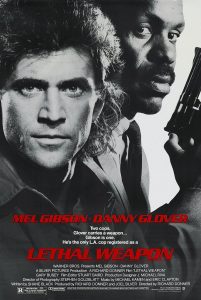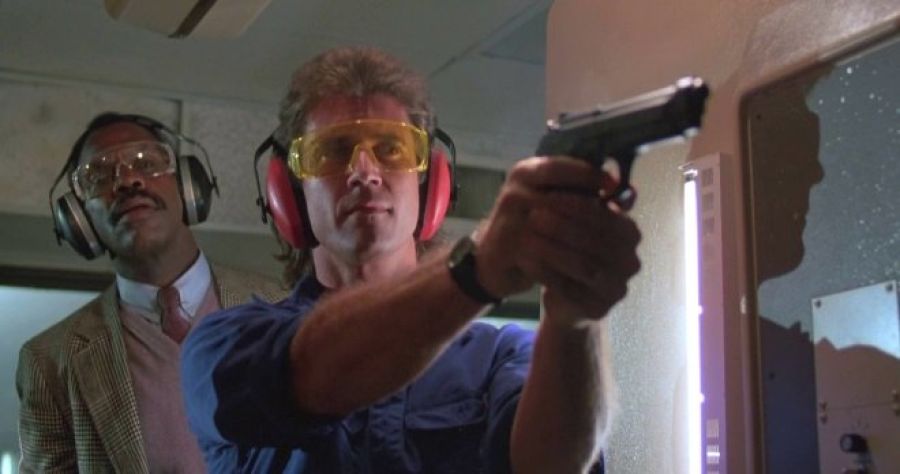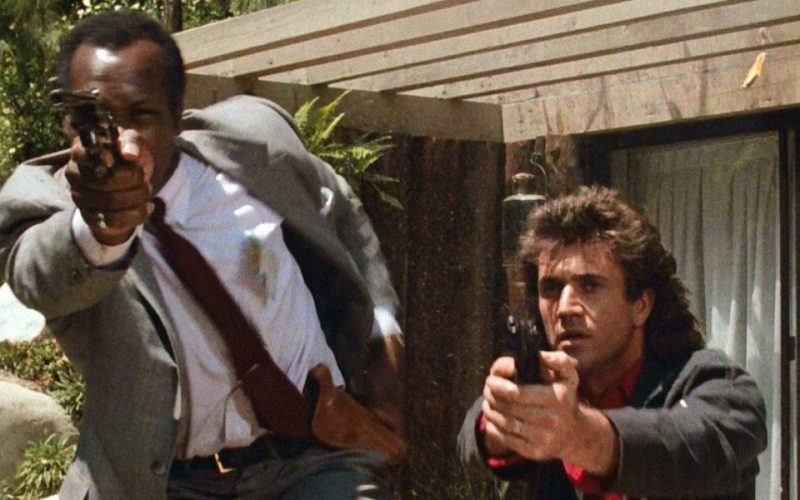Fact File – No.6 – Lethal Weapon (1987)
In this regular Film ‘89 feature we put a classic film or TV show under the microscope to unveil some juicy trivia. Some of these facts you may already know but hopefully you’ll find something new to enrich your experience and understanding of an important work of popular culture. In time for Christmas we have something of a festive action film (no, not Die Hard, we’ already covered that in Fact File No.2) that would go on to become an iconic entry in the crowded ‘80s Action Film genre. Mel Gibson and Danny Glover form an unlikely paring in one of the all-time great buddy cop movies, Lethal Weapon.
 Lethal Weapon (1987)
Lethal Weapon (1987)
Director: Richard Donner
1. The first draft ended up in the trash.
Shane Black was 23 years old and trying to become an actor when he wrote the first draft of Lethal weapon in less than six weeks. Not knowing what a huge hit he had on his hands, at one point Black gave up and threw the script into the trash. “I thought it was dreadful,” Black later admitted.
2. Too young for this shit.
Mel Gibson was only thirty years old when the movie was filmed, although his character Riggs was supposed to be thirty-eight. Danny Glover’s character, Roger Murtaugh, is fifty years old in the movie, but Glover was only forty years old in 1986 when the movie was filmed.
3. Some serious method in his madness.
In the scene where Riggs is contemplating suicide there is an actual bullet in the chamber which Mel Gibson was pointing at his head, thinking that it would allow him to portray the scene more realistically and dramatically.
4. Highly illogical.
Richard Donner ended up directing all four of the Lethal Weapon films, but that only happened after Leonard Nimoy — who had just shown his directing chops on Star Trek III: The Search for Spock (1984), Star Trek IV: The Voyage Home (1986), and 3 Men and a Baby (1987) — turned down the job. Nimoy was said not to be in favour of directing an action movie.
5. The western connection.
Director Richard Donner accepted the role on the proviso that the violence be toned down and used old westerns as his benchmark. ”I tried to make it more like an old-fashioned western,” Donner told The New York Times. ”Sure there were a lot of deaths, but they died like they died in westerns. They were shot with bullets, they weren’t dismembered.” Writer Shane Black also stated that his finished script was a modern day, urban western.
6. Old war buddies?
Murtaugh tells Riggs that Hunsaker saved his life in the La Drang Valley in 1965. Mel Gibson would later play Colonel Hal Moore in We Were Soldiers (2002), which is an adaptation of that same battle.
7. In memoriam.
Stuntman Dar Robinson was killed in a motorcycle accident shortly after principal photography was finished. Director Richard Donner dedicated the film to him. Jackie Swanson actually performed the high fall seen at the beginning of the movie on her own, thanks to her training from the legendary stunt master Robinson. The stunt was done using an airbag covered with a life-size painting of the driveway and cars, which, like a foreground miniature, visually blends into the real scene. Thus, the editor was able to hold the shot until just before she made contact with the airbag for greater realism.
8. Alternate scenes.
An alternate opening and ending were both filmed (and are available on the Lethal Weapon 4 DVD). The alternate opening featured Martin Riggs drinking alone in a bar, where he is accosted by a couple of thugs who want his money. Riggs claims all of his money is in the bank and tells the thugs not to fuck with him. The thugs attack Riggs but he easily subdues them. He is then allowed to take a free bottle of booze from the bar in exchange for never returning. Richard Donner felt the movie should open with a brighter look at Riggs and filmed the scene with him awakening in his trailer to replace it. The alternate ending featured Riggs and Murtaugh saying goodbye to one another. Murtaugh tells Riggs he’s thinking of retiring but Riggs tells him not to.
9. Role reversal.
According to a June 2007 Vanity Fair article, Bruce Willis was initially considered for the role of Riggs but turned it down. He got the lead role of John McClane in Die Hard (1988) after Mel Gibson turned that down. In another bizarre twist, a clip from Lethal Weapon is played on television in The Last Boy Scout (which featured Willis in the lead) and both movies were written by Shane Black and produced by Joel Silver. Also, Damon Wayans from that film, would play Roger Murtaugh on the recent 2016 Lethal Weapon television series.
10. Fight night.
The fight scene between Riggs and Mr. Joshua in the ending was originally four minutes longer, but was cut down for pacing. This explains some continuity mistakes in the final version of the scene. From the early pre-production stages, Richard Donner wanted the final fight sequence to be unique, yet also to make a strong statement about the characters involved. Coincidentally, Assistant Director Willie Simmons had an avid interest in unusual forms of martial arts,and he invited several practitioners to the set to demonstrate for Donner. The result was the hiring of three Technical Advisors, each a master of a particular martial arts style. Cedric Adams was the first expert brought in. “Adams thought the best possible way to show just how lethal Riggs really is is to show his mastery of a form of martial arts never before seen on-screen,” said Donner. Adams taught the actors the movements of Capoeira. A second Technical Advisor, Dennis Newsome, brought jailhouse rock to the fight sequence. The third Technical Advisor was Rorion Gracie, who specialized in Brazilian Jiu-Jitsu. The filming was spread over four complete nights, shooting from dusk until dawn, resulting in an final edited sequence that would last several minutes.
11. Hidden messages.
If you pay attention to stuff in the background, you’ll notice a “Free South Africa, End Apartheid” sticker on the Murtaughs’ fridge and other messages like anti-NRA and anti-tuna posters. “If you can make a good entertainment and sneak a message in, super,” Donner told Empire. “Sometimes people do it ass-backwards: make message films and then sneak the entertainment in.” Viewers definitely noticed; because of the sticker and South African-themed plot of the second film, Donner received death threats.
12. Casting decisions.
Nowhere in the script does it mention Murtaugh’s ethnicity. “We just got the best actor that we could for the part, and it happened to be that he was black” Donner said during a 1987 press conference for the move. In an interview with Empire, Donner explained that it was casting director Marion Dougherty who suggested Glover. “She said to me, ‘Did you see The Color Purple? What about Danny Glover?’ And my first reaction was, ‘But he’s black!’ And then I thought, ‘Whoa, f*ck, here’s Mr. Liberal. What a brilliant idea…’ I felt stupid. It changed my way of thinking.”
13. Mr Joshua.
On E! True Hollywood Story (1996), Gary Busey says he was hired to play Joshua because they were looking for someone big and menacing enough to be a believable foe for Mel Gibson. Busey also credits the film for reviving his failing movie career. “I always build a backstory for my characters, to get in the mood of it,” Busey told Empire. For this role, he went to an unusual place. “Mr. Joshua, he would walk through his grandmother’s blood to get a postage stamp and never look at her. I had this look, here” Busey said, and then took off his sunglasses. “It gave me the eyes of a shark, which has no life. It’s neat doing that.”
14. Deleted scenes.
Besides the re-shot ending, a couple of scenes were left out of the film (they were later included in the Director’s Cut), one in which Riggs attacks a sniper who’s shooting at a playground, and a scene where Riggs pays a prostitute to watch TV with him.
15. “3, 2, 1…. no wait!”
A running gag in the Lethal Weapon series is the “One, Two, Three” false starts where Riggs and Murtaugh can’t decide whether to go “One, Two, Three… then go!” or “One, Two, THREE!” (go ON “Three”) Whilst the gag does not exist in this film, there is a “One, Two, Three” false start in the movie. It happens when the uniformed cops are trying to sing Silent Night in a chorus and one of the cops keeps starting too soon.
16. Keeping it real.
Throughout filming, Technical Advisors from the L.A.P.D., as well as the Los Angeles County Sheriff’s Department, worked closely with Richard Donner and the actors to ensure authenticity. Stunt Coordinator Bobby Bass planned and supervised all phases of Mel Gibson,and Danny Glover’s intense pre-production training; physical conditioning, weight workouts, and weapons handling and safety. Bass also used his own military experiences to bring a greater depth of understanding to the Riggs character.
17. Alternative bad guys.
John Saxon was the first choice for the role of Joshua but due to him shooting A Nightmare on Elm Street 3: Dream Warriors (1987), he was unavailable. James Woods, Christopher Walken, Tommy Lee Jones, Keith Carradine, and Scott Glenn were also considered for the role of Mr. Joshua. Lee Marvin, Bruce Dern, Richard Jordan, James Earl Jones, Peter Boyle, and Robert Duvall were all considered for the role of General McAllister.
18. More Die Hard connections.
As well as both movies being set at Christmas time, the prop Beretta 92F handgun that Mel Gibson uses in this film is the same prop gun that would be used by by Bruce Willis in Die Hard a year later. Mary Ellen Trainor (the police psychologist Dr Stephanie Woods) and Grand L. Bush (Detective Boyette) had parts in Die Hard playing a news anchor and FBI agent agent Johnson respectively. Asian actor Al Leong would also play Riggs’ torturer Endo before appearing as the candy loving gunman Uli in Die Hard.
19. The King connection.
The soundtrack includes The Elvis Presley song, “I’ll Be Home for Christmas”. Darlene Love, who plays Murtaugh’s wife, was a background dancer in Elvis’ production Elvis (1968).
20. Alternative casting options.
Don Johnson and Tom Selleck, both of whom played famous TV cops, were considered for the role of Martin Riggs. The list of other actors who were either considered for the role or turned it down is said to include, Kurt Russell, Patrick Swayze, Michael Keaton, Nicolas Cage, Christopher Reeve, Harrison Ford, Liam Neeson, Pierce Brosnan, Kevin Costner, Eric Roberts, Michael Douglas, Richard Gere, William Petersen, Sean Penn, Jim Belushi, Christopher Lambert, Sylvester Stallone, Kevin Kline, William Hurt, Willem Dafoe, Bruce Willis, Richard Norton, Charlie Sheen, Jeff Goldblum, Dennis Quaid, Jeff Bridges, Arnold Schwarzenegger, and Rutger Hauer. Brian Dennehy was considered for the role of Roger Murtaugh. Dennehy turned it down as he felt he had already played a cop too many times.
21. Hard cell.
It is said to be the first movie to show a modern cell phone. It was a Portable Radio Shack Model 17-1003, launched circa 1986.
22. Super Riggs.
Lethal Weapon marks Richard Donner’s first R-rated film since The Omen (1976). Christopher Reeve, who had worked with the director on Superman, was one of Donner’s first choices for Martin Riggs but turned it down.
23. Festive facts.
Though the movie takes place during Christmas, the film was released in theatres in the US on March 6th 1987. Incidentally, Donner’s next film, Scrooged (1988), was also set at Christmas.
24. The Three Stooges connection.
There are several references to The Three Stooges in the film. Just like his character, Mel Gibson is big fan of The Three Stooges. He even produced the biopic The Three Stooges (2000).
25. Never too old.
Despite popular misconceptions, Roger Murtaugh (Danny Glover) never actually says, “I’m getting too old for this shit” in this movie. He simply says, “I’m too old for this shit.” He does, however, say he’s “getting too old for this shit” in the sequels.
Sources IMBD, Mental Floss.


